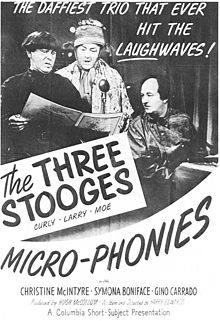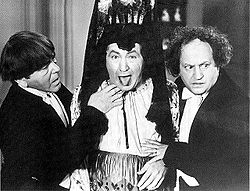- Micro-Phonies
-
- For the Cabaret Voltaire album, see Micro Phonies
Micro-Phonies 
Directed by Edward Bernds Produced by Hugh McCollum Written by Edward Bernds Starring Moe Howard
Larry Fine
Curly Howard
Christine McIntyre
Symona Boniface
Gino Corrado
Fred Kelsey
Lynton Brent
Sam Flint
Ted LorchCinematography Glen Gano Editing by Henry Batista Distributed by Columbia Pictures Release date(s) November 15, 1945 Running time 16' 45" Country United States Language English Micro-Phonies is the 87th short subject starring American slapstick comedy team the Three Stooges. The trio made a total of 190 shorts for Columbia Pictures between 1934 and 1959.
Contents
Plot
The trio are employed as handymen in a recording studio at the fictional radio station KGBY. While not doing their work, they hear a recording session as Alice Van Doren (Christine McIntyre) sings "Voices of Spring". She is recording this song under a pseudonym (Miss Andrews) to audition for a radio show, an endeavor to which her father (Sam Flint) objects. Impressed by the operatic virtuosity of this stunningly beautiful soprano, Curly lip syncs, as the other stooges adorn him as a woman.
Curly (in drag) is "heard" by the radio host Mrs. Bixby (Symona Boniface). Moe dubs Curly "Señorita Cucaracha," and the trio are hired to sing professionally on the radio, but must also appear at the home of the radio show’s sponsor for a party. Before they leave the studio, they have a run-in with an Italian baritone singer/violinist (Gino Corrado), and end up destroying his glasses and violin before the encounter is over. Little do the Stooges know the irate singer/violinist is also slated to perform at Mrs. Bixby's home that evening.
After sabotaging the baritone's vocal performance by tossing cherries into his mouth as he croons, the trio get ready for Curly to "perform." Moe's idea is to play "Voices of Spring" on the nearby, out-of-view phonograph while Curly mimes the words, just as he did convincingly at the recording studio. All is well at the party until Moe angrily breaks the record over Curly’s head, leaving the trio with no song. Larry spots a collection of records, hastily selects the "Lucia Sextet," and announces it as the "Sextet by Lucy". This song, however, requires pantomime by all three. This works well until the baritone recognizes them, and unplugs the phonograph midway through the "Lucia Sextet", leaving the trio groaning out loud. To prevent Curly from having to sing, Moe "concludes" that the Señorita has lost her voice.
Alice Van Doran is also present at the party, and catches onto the boys' scheme. To help them out of their jam, she hides behind a curtain and sings "Voices of Spring" live as Curly again mimics his way through. This works well until the baritone, wondering how Curly is "singing" without the aid of the phonograph, discovers Alice behind the curtain. The baritone quickly yanks off Curly's wig, and reveals the trio as a bunch of fakes. Alice's father, however, sees that his daughter has genuine talent, and decides she should indeed pursue her singing career. As for the Stooges, they are pelted with records and make a quick exit from the party.
Quotes
- Moe: (looking over a few records) "'Sextet by Lucy'..." (turns to Curly) "Can you sing it?"
- Curly: "I can't even SAY it!"
Notes
- A noted operatic singer, Christine McIntyre did all her own singing for this and all other shorts in which involved her character singing.
- The recording of Christine singing in the radio station can be heard again in Shemp's music teaching sequence from Brideless Groom.
Curly's illness
Micro-Phonies was produced after Curly Howard suffered a mild stroke. As a result, his performance was marred by slurred speech and slower timing. Though Micro-Phonies was the first film released that was directed by novice director Edward Bernds, it was not his first attempt. That honor goes to the lackluster A Bird in the Head. Understandably, Bernds was excited at his big chance to direct, but was shocked when he saw how ill Curly had become.[1] Years later, Bernds discussed his trying experience during the filming of A Bird in the Head:
“ It was an awful tough deal for a novice rookie director to have a Curly who wasn't himself.[2] I had seen Curly at his greatest and his work in this film was far from great. The wallpaper scene was agony to direct because of the physical movements required to roll up the wallpaper and to react when it curled up in him. It just didn't work. As a fledgling director, my plans were based on doing everything in one nice neat shot. But when I saw the scenes were not playing, I had to improvise and use other angles to make it play. It was the wallpaper scene that we shot first, and during the first two hours of filming, I became aware that we had a problem with Curly.[1] ” Bernds feared that his directing days would be over as soon as they began if A Bird in the Head (featuring a sluggish Curly) was released as his first effort. Producer Hugh McCollum acted quickly, and reshuffled the release order of the films Bernds had directed (Bernds had already completed Micro-Phonies and The Three Troubledoers in addition to A Bird in the Head). As a result, the superior Micro-Phonies (in which Curly was on his mark) was released first, securing Bernds's directing position. Bernds would forever be indebted to McCollum for this act of kindness; henceforth, McCollum produced all of Bernds's Stooge films.[2]
Bernds later recalled how Curly's condition would have its peaks and valleys:
“ ...it was strange the way he (Curly) went up and down. In the order I shot the pictures, not in the order they were released, he was down for A Bird in the Head and The Three Troubledoers, he was up for Micro-Phonies, way down for Monkey Businessmen, and then up again, for the last time, in Three Little Pirates.[3] ” References
- ^ a b Howard Maurer, Joan; Jeff Lenburg, Greg Lenburg (1982). The Three Stooges Scrapbook. Citadel Press. pp. 76. ISBN 0806509465. http://www.amazon.com/Three-Stooges-Scrapbook-Joan-Howard-Maurer/dp/0806509465/ref=pd_sim_b_title_1.
- ^ a b Fleming, Michael (1999). The Three Stooges: An Illustrated History, From Amalgamated Morons to American Icons. Broadway Publishing. pp. 79, 80. ISBN 0767905567. http://www.amazon.com/Three-Stooges-Illustrated-Amalgamated-American/dp/0767905563/ref=sr_1_1?ie=UTF8&s=books&qid=1201628331&sr=1-1.
- ^ Okuda, Ted; Watz, Edward; (1986). The Columbia Comedy Shorts, pp. 66-67, McFarland & Company, Inc., Publishers. ISBN 0-89950-181-8
External links
- Micro-Phonies at the Internet Movie Database
- Micro-Phonies at AllRovi
- Micro-Phonies at threestooges.net
Categories:- 1945 films
- American films
- English-language films
- Short films
- The Three Stooges films
- American comedy films
- Black-and-white films
- Films directed by Edward Bernds
Wikimedia Foundation. 2010.

